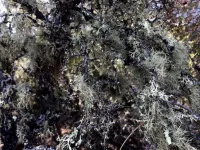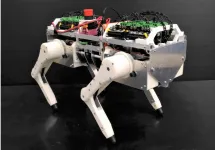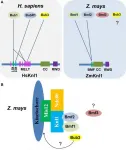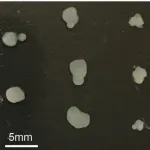(Press-News.org) Lichen communities may take decades -- and in some cases up to a century -- to fully return to chaparral ecosystems after wildfire, finds a study from the University of California, Davis, and Stanford University.
The study, published today in the journal Diversity and Distributions, is the most comprehensive to date of long-term lichen recolonization after fire.
Unlike conifer forests, chaparral systems in California are historically adapted to high-intensity fires -- they burn hot, fast and tend to regenerate quickly. However, with more frequent fires predicted under a drier, warming climate and more ignitions occurring amid a growing human population in these areas, the study indicates that lichen communities may not receive the window of opportunity they need to return to chaparral shrublands after wildfire.
"In chaparral systems, lichens can come back 20 to 30 years after fire, but if you get into more frequent burning several times in a short time period, it may be there isn't a place for these lichens," said co-leading author Alexandra Weill, who conducted the research while a graduate student researcher in the UC Davis Department of Plant Sciences.
OVERLOOKED AND ALL AROUND
Lichens are complex organisms born from a symbiosis of fungi and algae. Overlooked and yet all around, they present a variety of colorful and intricate shapes and patterns along the rocks, branches and floor of forests and other biomes. They not only provide food for wildlife, they also help retain moisture in their environments -- an increasingly important service in dry chaparral systems.
"There's also value to biodiversity itself," said co-leading author Jesse Miller, a UC Davis postdoctoral researcher at the time of the study and currently a lecturer at Stanford. "In our study, plant diversity was low under the dense shrub canopy. But we could find dozens of lichen species in the same area. If we lose these lichens, we're losing a lot of the actual biodiversity that's there."
NOT 'LICHEN' FREQUENT FIRE
To test how lichens recolonized in chaparral systems after fire, the scientists in 2018 sampled lichen communities at two UC Davis natural reserves -- Quail Ridge and nearby Stebbins Cold Canyon in Napa and Solano counties. Using records from CAL FIRE and Quail Ridge Reserve, they identified fire boundaries that occurred within the reserves since 1950. They sampled five fires: the 1953 T. Viue Fire, 1988 Resort Fire, 2005 Pleasure Fire, an unnamed 1996 fire and the 2015 Wragg Fire.
After identifying plots to survey at these locations, they crawled under the chaparral to document every lichen species they could find and its abundance.
They found that fire-intolerant species like lichens may be slow to recolonize landscapes after high-severity fire. Most chaparral lichen taxa could be lost if fire intervals shorten to less than 20 years, which has already occurred in some parts of California, the study said.
OLD-GROWTH CHAPARRAL
The researchers also compared the species richness of lichens found in these previously burned areas to old-growth chaparral sites with no recorded fire history. They found such old-growth vegetation may promote biodiversity, and the study highlights its value.
"Old-growth chaparral doesn't have the charisma of a redwood forest," Miller said. "Most people wouldn't recognize it as a 100-year-old plus mini-forest if they walk by. But all ecosystems have old-growth states of unique species that don't occur in areas of recent disturbance. Our study builds on the idea that we need to recognize the value of communities that take a long time to form."
MANAGEMENT STRATEGY
The study suggests a land management strategy that aims for "a well-maintained mosaic of land types," including areas of old-growth chaparral and areas that are managed with prescribed fire. Such a strategy, when paired with prevention and home protection efforts, could help reduce fire risk while maximizing cultural and ecological value.
"For most Californians, chaparral shrublands are the closest and most accessible ecosystems we have," said Weill. "If you're going to Mt. Tam, you're hiking in chaparral. If you're hiking in LA, you're in chaparral. For the average Californian, this is what's most likely in your backyard. But that's also what makes it an issue because these are the fires threatening your home."
INFORMATION:
The study was funded by the California Lichen Society.
In order for metal nanomaterials to deliver on their promise to energy and electronics, they need to shape up -- literally.
To deliver reliable mechanical and electric properties, nanomaterials must have consistent, predictable shapes and surfaces, as well as scalable production techniques. UC Riverside engineers are solving this problem by vaporizing metals within a magnetic field to direct the reassembly of metal atoms into predictable shapes. The research is published in The Journal of Physical Chemistry Letters.
Nanomaterials, which are made of particles measuring 1-100 nanometers, are typically ...
Almost half (47.5%) of women with babies aged six months or younger met the threshold for postnatal depression during the first COVID-19 lockdown, more than double average rates for Europe before the pandemic (23%), finds a new study led by UCL researchers.
Women described feelings of isolation, exhaustion, worry, inadequacy, guilt, and increased stress. Many grieved for what they felt were lost opportunities for them and their baby, and worried about the developmental impact of social isolation on their new little one.
Those whose partners were unable or unavailable to help with parenting and domestic ...
Air quality in Spain temporarily improved during the first wave of COVID-19, largely as a result of mobility restrictions. Until recently, however, the effect of this improvement on the health of the population was poorly understood. A new study led by the Barcelona Institute for Global Health (ISGlobal), a centre supported by the "la Caixa" Foundation, together with the Barcelona Supercomputing Center (BSC-CNS), has estimated that this improvement in air quality prevented around 150 premature deaths in Spain's provincial capital cities.
Several analyses have estimated the mortality reduction from improved ...
The tightly defined ratios of metals in MOFs makes them ideal starting materials for novel catalyst creation.
Heating bimetallic metal organic frameworks (MOFs) until their porous structure collapses into nanoparticles can be a highly effective way to make catalysts. This novel approach to catalyst design has now been used by KAUST and Spanish researchers to make a robust catalyst that converts carbon dioxide (CO2) into carbon monoxide (CO) gas with unprecedented selectivity.
The benefit of this method pioneered at KAUST is that it can generate mixed metal catalytic nanoparticles that have proven challenging or impossible to make by conventional means.
Capturing ...
Published today in Nature Communications, the team from the Peter Doherty Institute for Infection and Immunity (Doherty Institute), Alfred Health and Monash University sought to understand which patients would recover quickly from influenza and which would become severely ill.
The four-year project took samples from patients hospitalised with influenza at up to five time points during their hospital stay, and 30 days after discharge. They analysed the breadth of the immune response, enabling them to describe the specific roles of several different types of immune cells, including killer and helper T cells, B cells and innate cells.
University of Melbourne Dr Oanh Nguyen, Research Fellow at the Doherty Institute, said two significant findings of the research include understanding ...
A group of researchers from Osaka University developed a quadruped robot platform that can reproduce the neuromuscular dynamics of animals (Figure 1), discovering that a steady gait and experimental behaviors of walking cats emerged from the reflex circuit in walking experiments on this robot. Their research results were published in Frontiers in Neurorobotics.
It was thought that a steady gait in animals is generated by complex nerve systems in the brain and spinal marrow; however, recent research shows that a steady gait is produced by the reflex circuit alone. Scientists discovered a candidate of reflex circuit to generate the steady walking motion ...
Dr. HAN Fangpu's group from the Institute of Genetics and Developmental Biology of the Chinese Academy of Sciences reports the identification and functional study of the maize Knl1 gene in an article published online in PNAS. The gene is a major component of the KMN network that links centromeric DNA and the plus-ends of spindle microtubules. It also plays an important role in kinetochore protein recruitment.
The kinetochore complex that assembles on the centromeres mediates the proper partitioning of chromosomes to daughter cells during the cell cycle. However, kinetochore proteins undergo frequent mutations and coevolve with their interaction partners, leading to great diversity in kinetochore composition in eukaryotes.
Functional ...
A team of researchers, affiliated with UNIST has recently introduced a new class of magnetic materials for spin caloritronics. Published in the February 2021 issue of Nature Communications, the demonstrated STE applications of a new class of magnets will pave the way for versatile recycling of ubiquitous waste heat. This breakthrough has been led by Professor Jung-Woo Yoo and his research team in the Department of Materials Science and Engineering at UNIST.
Spin thermoelectrics is an emerging thermoelectric technology that offers energy harvesting from waste heat. ...
Like many around the world, the lab of Professor Mriganka Sur in The Picower Institute for Learning and Memory at MIT has embraced the young technology of cerebral organoids, or "minibrains," for studying human brain development in health and disease. By making a surprising finding about a common practice in the process of growing the complex tissue cultures, the lab has produced both new guidance that can make the technology better, and also new insight into the important roles a prevalent enzyme takes in natural brain development.
To make organoids, scientists take skin cells from a donor, induce them to become stem cells and then culture those in a bioreactor, guiding their development with the addition of growth ...
COLUMBUS, Ohio - People are more persuaded by the actual messages contained in social media posts than they are by how many others viewed the posts, a new study suggests.
Researchers found that when people watched YouTube videos either for or against e-cigarette use, their level of persuasion wasn't directly affected by whether the video said it was viewed by more than a million people versus by fewer than 20.
What mattered for persuasion was viewers' perception of the message as truthful and believable.
"There wasn't a bandwagon effect in which people were persuaded by a video just because ...




